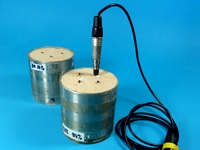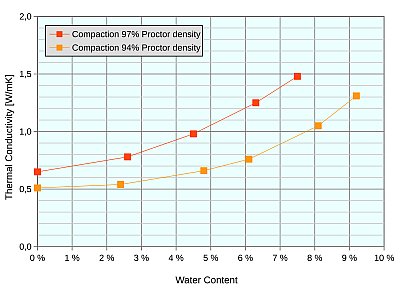Thermal Conductivity Tests of Sand and Soil Samples
 Sand and soil samples consist of solid grains (the matrix) and pores filled with air and/or water. The thermal conductivity of the matrix is higher than the thermal conductivity of water, which is much higher than that of air. This means that the proportions of solid grains, air and water strongly influence the overall thermal conductivity/resistivity of sand and soil.
Sand and soil samples consist of solid grains (the matrix) and pores filled with air and/or water. The thermal conductivity of the matrix is higher than the thermal conductivity of water, which is much higher than that of air. This means that the proportions of solid grains, air and water strongly influence the overall thermal conductivity/resistivity of sand and soil.
Water content and compaction of sand and soil samples are required for correct interpretation of the test results.
![arrow]() Moisture Content
Moisture Content
 When a porous material is dry, the pores are filled with air (thermal conductivity about 0.03 W/mK). When saturated, the pores are instead filled with water (thermal conductivity about 0.6 W/mK). As a result, the thermal conductivity of sand and soil increases with increasing water content.
When a porous material is dry, the pores are filled with air (thermal conductivity about 0.03 W/mK). When saturated, the pores are instead filled with water (thermal conductivity about 0.6 W/mK). As a result, the thermal conductivity of sand and soil increases with increasing water content.
The maximum thermal conductivity (saturated) can exceed the minimum (dried) by a factor of 5 or 6. As the correlation is non-linear, the thermal conductivity values of sand or soil only provide useful information if the water content at the time of measurement is known. Depending on the purpose of the test, it may be necessary to measure at more than one water content.
To determine the complete thermal conductivity / resistivity versus moisture curve (dry-out curve), 5 to 10 measurements at different water contents are required. Two measurements (one saturated and one completely dry) are necessary to establish the maximum and minimum values.
![arrow]() Density and Compaction
Density and Compaction
 Well-compacted sand and soil samples have a low pore volume and a high proportion of solid grains. Since the solid components have a higher thermal conductivity than the pore filling, such a sample will have a higher thermal conductivity than the same material when poorly compacted.
Well-compacted sand and soil samples have a low pore volume and a high proportion of solid grains. Since the solid components have a higher thermal conductivity than the pore filling, such a sample will have a higher thermal conductivity than the same material when poorly compacted.
If a sand compacts well depends largely on its grain size distribution. Well-graded materials result in a higher density when installed on site than uniformly graded sands.
When taking samples in the field, it is important to maintain the structural integrity of the material to avoid any influence on the test results. Test samples prepared in the lab from loose material must be compacted to the same degree as will be used later on the construction site. Our application note (PDF) Taking soil samples for thermal conductivity tests provides further details.


